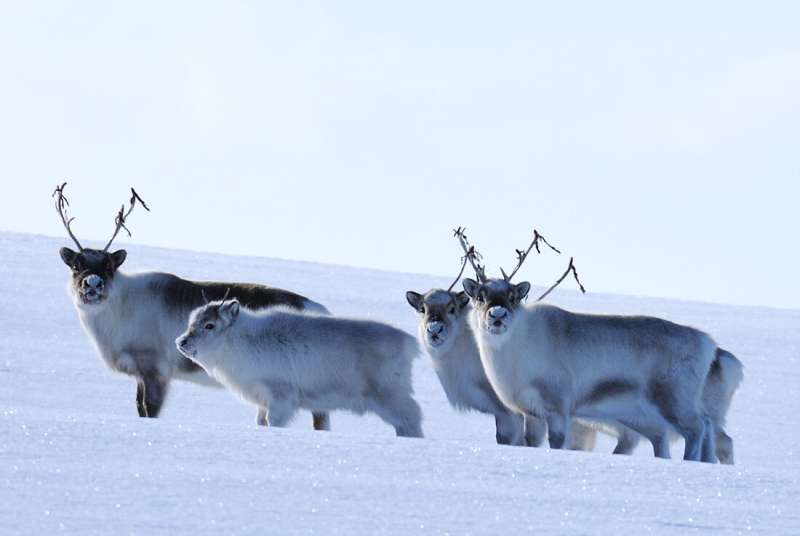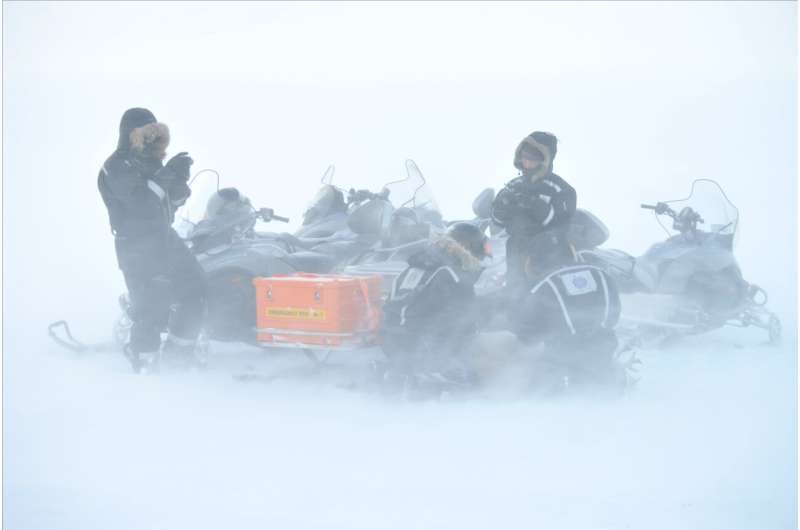Rudolph is coping with climate change better than feared—for now

The North Pole is not what it once was. The Arctic is the area on the globe where temperatures are rising the fastest. On Svalbard, a Norwegian archipelago in the Arctic Ocean, this entails extended periods of mild weather. Precipitation comes as rain, snow melts, and then freezes again in colder periods. These alternations between hot and cold result in the ground being covered in ice. That is a problem for the Svalbard reindeer: when ice covers the ground, food becomes unavailable.
"In a normal Svalbard winter, the ground is covered with snow and the animals can dig for food," says Leif Egil Loe, professor of wildlife biology at the Norwegian University of Life Sciences (NMBU).
Fluffy snow is easy to get through. Hard ice is much more difficult, sometimes impossible.
Until recently, these icy winters dictated the population size: The numbers built up over a few years, then plummeted when the ground became covered in ice and many animals had to compete for the few plants they could find. In the last ten years, however, something new has happened.
Fatter than usual
Over the past 25 years, Loe and his colleagues have caught and weighed about 1000 female reindeer on Svalbard. They have also tracked the population numbers.
Surprisingly, the reindeer population has grown continuously over the past 10 years, even though there have been icy winters. This indicates that the animals are coping well with the new milder winters, they were fatter in the spring than usual.
"In the years and areas where the snow arrived late, the animals were on average 5 kilograms and ten percent heavier at the end of winter."
Larger dinner plate
The reason for Rudolph's increased fat layer is changes in food availability.
"The growing season on Svalbard is very short," says Loe.
The plants' growing season usually lasts from early June to mid-August, but there are big differences between years.
In a warmer climate, the plants start earlier in the spring, and live longer into the autumn. A hot summer produces twice as much reindeer food as a cold Svalbard summer, and this food is available for most of the year.
Warmer autumns with later snowfalls have therefore more than compensated for the fact that the winter has become icier.
"This is probably the main explanation why the population size in our study area has almost tripled in the last three decades," he says.
A Svalbard local
Svalbard reindeer is a separate subspecies of reindeer. It is smaller than most other subspecies, and only occurs on Svalbard.
"Reindeer can be found in most of the areas that are not covered by glaciers," says Loe.

There are approximately 20,000-25,000 reindeer on Svalbard, but the population varies, both geographically and over time.
"In contrast to the large herds people usually associate with reindeer, the Svalbard reindeer like to stay together in smaller groups."
They reindeer probably came across the ice around 6,000 years ago. Genetic studies indicate that the population originated in Siberia and north-western parts of Russia, and came to Svalbard via Novaya Zemlya and Franz Josef Land.
A changing ecosystem
"Svalbard will probably look quite different in the future," Kari Klanderud says, an NMBU-professor of plant ecology.
She has done a lot of research on how climate change will affect Scandinavian plant communities.
"Warmer weather favors grass and flowering plants at the expense of the mosses that dominate today."
The changes in the plant communities will probably also be self-reinforcing because the plants will change the soil. The reindeer's food supply will therefore most likely continue to increase.
Too hot for an animal of the ice age?
In addition to changes in local flora, it is also possible that there will be more winter grazing for the animals in the future.
High winter temperatures will eventually expose more pastures in winter, instead covering them with ice.
"If these trends take hold, the future for the reindeer on Svalbard could be brighter than what we have so far feared," says Loe.
However, he is still not super optimistic on behalf of the reindeer.
"On hot summer days, we see that the reindeer choose resting places on cold patches of soil, in bogs or on snow."
"The animals' activity levels also drop sharply when temperatures exceed 12 degrees Celsius."
These summer temperatures are now becoming increasingly common on Svalbard.
"Although the reindeer can be considered a climate winner in the last 28 years, and the food supply will continue to increase, the physiological challenges for this Ice Age animal will probably be felt in the near future," Loe concludes.
But Santa does not need to bring extra food on the sleigh for Rudolph and the rest of his flock this year at least.
The findings are published in the journal Global Change Biology.
More information: Leif Egil Loe et al, The neglected season: Warmer autumns counteract harsher winters and promote population growth in Arctic reindeer, Global Change Biology (2020). DOI: 10.1111/gcb.15458
Journal information: Global Change Biology
Provided by Norwegian University of Life Sciences




















